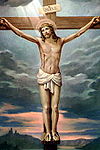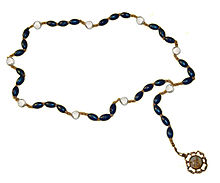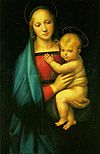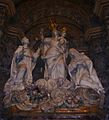- Rosary
-
This article is about the Catholic Marian devotion. For other forms of the Christian rosary, see Rosary based prayers. For prayer beads in other religions, see Prayer beads.
Roman Catholic Mariology
A series of articles onRosary

Blessed Virgin Mary
Devotions & spirituality
Our Lady of the Rosary
Battle of Lepanto
History of the rosary
Praying methods
Rosary & ScapularPrayers & Promises
The Mysteries
Rosary based prayers
Rosary of the Holy Wounds
Three Hail Marys
Fatima Prayer
Fifteen rosary promises
Power of the RosaryWritings
Secret of the Rosary
God Alone
Ingruentium Malorum
Marialis Cultus
Rosarium Virginis Mariae
The Power of the RosaryPeople & Societies
Saint Dominic
Bl. Alanus de Rupe
Pope St. Pius V
St. Louis de Montfort
Rosary Pope (Leo XIII)
Confraternity of the Rosary
Our Lady's Rosary MakersThe rosary (from Latin rosarium, meaning "rose garden")[1] or "garland of roses"[2] is a traditional Catholic devotion. The term denotes the prayer beads used to count the series of prayers that make up the rosary. The prayers consist of repeated sequences of the Lord's Prayer followed by ten prayings of the Hail Mary and a single praying of "Glory Be to the Father" and is sometimes accompanied by the Fatima Prayer; each of these sequences is known as a decade. The praying of each decade is accompanied by meditation on one of the Mysteries of the Rosary, which recall the life of Jesus Christ.
The traditional 15 Mysteries of the Rosary were standardized, based on the long-standing custom, by Pope St. Pius V in the 16th century. The mysteries are grouped into three sets: the joyful mysteries, the sorrowful mysteries, and the glorious mysteries. In 2002, Pope John Paul II announced five new optional mysteries, the luminous mysteries, bringing the total number of mysteries to 20.
The term has come to be used to refer to similar beads in other religions.[3]
Theological significance
The rosary is part of the Catholic veneration of Mary, which has been promoted by numerous popes, especially Leo XIII, known as "The Rosary Pope", who issued twelve encyclicals and five apostolic letters on the rosary and added the invocation Queen of the most Holy Rosary to the Litany of Loreto. Pope Pius V introduced the rosary into the Roman Catholic liturgical calendar as the Feast of Our Lady of the Rosary, celebrated on October 7. Most recently, on May 3, 2008, Pope Benedict XVI stated that the Rosary is experiencing a new springtime: "It is one of the most eloquent signs of love that the young generation nourish for Jesus and his Mother."[4] To Benedict XVI, the rosary is a meditation on all important moments of salvation history.[4] Before him, Pope John Paul II's Apostolic Letter Rosarium Virginis Mariae[5] built on the "total Marian devotion" pioneered by Saint Louis de Montfort. Pope Pius XII and his successors actively promoted the veneration of the Virgin in Lourdes and Fatima, which is credited with a new resurgence of the rosary within the Catholic Church.[6]
The theologian Romano Guardini defined the Roman Catholic emphasis on the rosary as "participation in the life of Mary, whose focus was Christ".[7] His statement echoed the view that in Roman Catholic Mariology the path to Christ is through Mary, with Mariology being inherent in Christology; a sentiment also expressed by saints such as Louis de Montfort who was a strong rosary advocate.[8][9] Pope Leo XIII also viewed the rosary as a vital means to participate in the life of Mary and to find the way to Christ (see the section on Rosary Pope below).[10]
Many similar prayer practices exist in other Christian communities, each with its own set of prescribed prayers and its own form of prayer beads, such as the prayer rope in Eastern Orthodox Christianity. These other devotions and their associated beads are usually referred to as "chaplets". The rosary is sometimes used by other Christians, especially in Lutheranism, the Anglican Communion and the Old Catholic Church. Other Protestants, however, such as Baptists and Presbyterians, do not use it and actively discourage their members from using this method of prayer.
Devotions and spirituality
Main article: Rosary devotions and spiritualityDevotion to the rosary is one of the most notable features of popular Catholic spirituality.[11] Pope John Paul II placed the rosary at the very center of Christian spirituality and called it "among the finest and most praiseworthy traditions of Christian contemplation."[12][13]
Saints and popes have emphasized the meditative and contemplative elements of the rosary and provided specific teachings for how the rosary should be prayed, for instance the need for "focus, respect, reverence and purity of intention" during rosary recitations and contemplations.[14]
From the sixteenth century onwards, rosary recitations often involved "picture texts" that assisted meditation. Such imagery continues to be used to depict the mysteries of the rosary. Saints have stressed the importance of meditation and contemplation. Scriptural meditations on the rosary build on the Christian tradition of Lectio Divina, (literary divine reading) as a way of using the Gospel to start a conversation between the soul and Christ. Padre Pio, who was devoted to the rosary, said: "Through the study of books one seeks God; by meditation one finds him."[15]
References to the rosary have been part of a number of reported Marian Apparitions spanning two centuries. The reported messages from these apparitions have influenced the spread of rosary devotions worldwide.[16][17] In Quamquam Pluries Pope Leo XIII related rosary devotions to Saint Joseph and granted indulgences for adding a prayer to St. Joseph to the Rosary during the month of October.[18]
History
Main article: History of the rosaryThere are differing views on the history of the rosary. According to tradition, the rosary was given to Saint Dominic in an apparition by the Blessed Virgin Mary in the year 1214 in the church of Prouille. This Marian apparition received the title of Our Lady of the Rosary.[19] In the 15th century it was promoted by Blessed Alanus de Rupe (aka Alain de la Roche or Saint Alan of the Rock), a learned Dominican priest and theologian, who established the "15 rosary promises" and started many rosary confraternities. However, most scholarly research suggests a more gradual and organic development of the rosary.[20]
The practice of meditation during the praying of the Hail Marys is attributed to Dominic of Prussia (1382–1460), a Carthusian monk, who called it "Life of Jesus Rosary" [6] The German monk from Trier added a sentence to each of the 50 Hail Marys, using quotes from scriptures.[6][21] In 1569, the papal bull Consueverunt Romani Pontifices by the Dominican Pope Pius V officially established the devotion to the rosary in the Catholic Church.[22][23]
From the 16th to the early 20th century, the structure of the rosary remained essentially unchanged.[20] There were 15 mysteries, one for each of the 15 decades. In the 20th century the addition of the Fatima Prayer to the end of each decade became more common. There were no other changes until 2002 when John Paul II instituted five optional new Luminous Mysteries.
Approved form
- A sign of the cross on the Crucifix and then the Apostles' Creed;
- An Our Father on the first large bead;
- A Hail Mary on each of the three small beads with the following intentions (the theological virtues):
- For the increase of faith
- For the increase of hope
- For the increase of charity
- A Glory Be to the Father;
- Announce the mystery
- An "Our Father" on the large bead
- A "Hail Mary" on each of the adjacent ten small beads;
- A "Glory Be to the Father";
- (The Fatima Prayer is commonly added here, as a pious addition: "O My Jesus, Forgive us our sins. Save us from the fires of hell. Lead all souls to Heaven. Especially those most in need of thy mercy.")
- Again an Our Father on the next large bead, followed by ten Hail Marys on the small beads, the Glory Be to the Father, (and Fatima Prayer, cf. below) for each of the following decades;
- In conclusion, Hail Holy Queen and a sign of the cross.
Variations and common pious additions
Many people add a praying of the Fatima Decade Prayer at the end of each Decade. Some add the Miraculous Medal prayer "O Mary, conceived without sin..." or the Fatima Ave refrain ("Ave, Ave, Ave Maria! Ave, Ave, Ave Maria!"). Others add a praying of a pious Eucharistic prayer "O Sacrament Most Holy, O Sacrament Divine, All praise and all thanksgiving be every moment Thine" at the end of each decade in honor of Jesus in the Blessed Sacrament. In the practice of the Brothers of the Christian Schools, they have an additional decade for the intentions of the students or the Blessed Virgin Mary.
A pious German custom is to insert a phrase in the middle of each Hail Mary (after "... Blessed is the Fruit of Thy Womb, Jesus ... "), which refers to the specific mystery being meditated upon.[24][25] This custom was incorporated into St. Louis de Montfort's second method out of his five Methods of Praying the Rosary.[26]
After Hail, Holy Queen many people add the prayer "O God, by Your Only Begotten Son...", the prayer to archangel Michael, prayer for the intentions of the Holy Father and finish with the Litany of Loreto.
In the practice of the Dominican Order, the opening prayers of the rosary mirror the opening of the Divine Office:[27]
- In the Name of the Father, and of the Son, and of the Holy Spirit. Amen.
- Hail Mary, full of grace, the Lord is with Thee.
- Blessed art Thou among women, and Blessed is the Fruit of Thy Womb, Jesus.
- O Lord, open my lips.
- And my mouth will proclaim Your praise.
- Incline Your aid to me, O God.
- O Lord, make haste to help me.
- Glory be to the Father, and to the Son, and to the Holy Spirit, as it was in the beginning, is now, and ever shall be, world without end. Amen.[28]
Mysteries of the rosary
Roman Catholic Mariology
A series of articles on
Alma Redemptoris Mater
Angelus
As a Child I Loved You
Ave Maris Stella
Ave Regina Caelorum
Fatima Prayers
Flos Carmeli
Hail Mary
Hail Mary of Gold
Immaculata prayer
Immaculate Mary
Magnificat
Mary Our Queen
Memorare
Regina Coeli
Rosary
Salve Regina
Stabat Mater
Sub tuum praesidium
Three Hail MarysThe Mysteries of the rosary follow the life of Christ from the Annunciation to the Ascension. They are meant as meditations on the life of Christ. The meditations are known as the Joyful (sometimes Joyous) Mysteries; the Sorrowful Mysteries; and the Glorious Mysteries. Each of these Mysteries has within it five different stages of Christ's life to be contemplated. Pope John Paul II, in his apostolic letter Rosarium Virginis Mariae (October 2002), recommended an additional set called the Luminous Mysteries (or the "Mysteries of Light").[29] Traditional Catholics who prefer the original fifteen mysteries point to the belief that the Rosary is Mary's Psalter, containing 150 Hail Marys in its body for the 150 Psalms.[30] Moreover, traditional Catholics sometimes do not pray the Luminous Mysteries of John Paul II because they assert that the Holy Rosary with its fifteen mysteries was instituted directly by the Mother of God.[31] Traditional Catholics hold that if Mary instituted 150 Hail Mary's with fifteen distinct mysteries, then not even a Pope can "add" to what she commanded - just as a Pope could not also "add" extra Psalms to the Bible. This belief is also based on the vision of Our Lady of Fatima, which speak of 150 Hail Mary's and "one third of the Rosary" being only five decades. The Luminous Mysteries bring the total to 200 Hail Mary's, which would contradict Mary's words. Moreover, advocates of the traditional fifteen decade Rosary note that it parallels Saint Paul's threefold progression of his argument in Philippians 2: 5-11, namely the Incarnation, the Passion, and the Exaltation of Christ corresponding to the Joyful, Sorrowful, and Glorious Mysteries.
Various other "mysteries" exist; in the German-speaking countries a fifth set of mysteries had become more common before the 1920s, the so-called "Comforting Mysteries", which have an eschatological dimension, meditating Christ as Universal King.[32]
Joyful Mysteries
- The Annunciation. Fruit of the Mystery: Humility
- The Visitation. Fruit of the Mystery: Love of Neighbors
- The Nativity. Fruit of the Mystery: Poverty (poor in spirit), Detachment from the things of the world, Contempt of Riches, Love of the Poor
- The Presentation of Jesus at the Temple. Fruit of the Mystery: Purity, Obedience
- The Finding of the Child Jesus in the Temple. Fruit of the Mystery: True Wisdom and True Conversion, Piety, Joy of Finding Jesus
Luminous Mysteries
- The Baptism of Jesus in the Jordan. Fruit of the Mystery: Openness to the Holy Spirit, the Healer.
- The Wedding at Cana. Fruit of the Mystery: To Jesus through Mary. The understanding of the ability to manifest-through faith.
- Jesus' Proclamation of the Kingdom of God. Fruit of the Mystery: Trust in God (Call of Conversion to Messiah)
- The Transfiguration. Fruit of the Mystery: Desire for Holiness
- The Institution of the Eucharist. Fruit of the Mystery: Adoration
Sorrowful Mysteries
- The Agony in the Garden. Fruit of the Mystery: Sorrow for Sin, Uniformity with the will of God
- The Scourging at the Pillar. Fruit of the Mystery: Mortification, Purity
- The Crowning with Thorns. Fruit of the Mystery: Contempt of the world, Courage
- The Carrying of the Cross. Fruit of the Mystery: Patience
- The Crucifixion. Fruit of the Mystery: Salvation, Forgiveness
Glorious Mysteries
- The Resurrection. Fruit of the Mystery: Faith
- The Ascension. Fruit of the Mystery: Hope and desire for ascension to Heaven
- The Descent of the Holy Spirit. Fruit of the Mystery: Holy Wisdom to know the truth and share with everyone, Divine Charity, Worship of the Holy Spirit
- The Assumption of Mary. Fruit of the Mystery: Grace of a Happy Death and True Devotion towards Mary
- The Coronation of the Blessed Virgin Mary. Fruit of the Mystery: Perseverance and Crown of Glory, Trust in Mary's Intercession
Days of praying
The full rosary consists of praying either all 3 traditional sets of mysteries (joyful, sorrowful and glorious) or the 3 traditional sets of mysteries plus the luminoous mysteries. One can pray the complete rosary (i.e. all 15 or 20 mysteries) each day. When praying just one set of mysteries per day, traditionally the prayers take the following format:
Day of praying With the Luminous Mysteries Without the Luminous Mysteries Sunday The Glorious Mysteries Advent and Christmas: The Joyful Mysteries
Lent to Palm Sunday: The Sorrowful Mysteries
Ordinary Time, Easter to Sunday before Advent: The Glorious MysteriesMonday The Joyful Mysteries The Joyful Mysteries Tuesday The Sorrowful Mysteries The Sorrowful Mysteries Wednesday The Glorious Mysteries The Glorious Mysteries Thursday The Luminous Mysteries The Joyful Mysteries Friday The Sorrowful Mysteries The Sorrowful Mysteries Saturday The Joyful Mysteries The Glorious Mysteries Rosary Novena
The "54-day Rosary Novena" is an uninterrupted series of Rosaries in honor of the Blessed Virgin Mary, reported as a revelation by Fortuna Agrelli of Our Lady of Pompeii at Naples in 1884.[33] For thirteen months Fortuna Agrelli had endured dreadful sufferings and torturous cramps; she had been given up by the most celebrated physicians. On February 16, 1884, the afflicted girl and her relatives commenced a novena of Rosaries. The Queen of the Holy Rosary favored her with an apparition on March 3. Mary, sitting upon a high throne, surrounded by luminous figures, held the divine Child on her lap, and in her hand a Rosary. The Virgin Mother and the holy Infant were clad in gold-embroidered garments. They were accompanied by St. Dominic and St. Catherine of Siena. The throne was profusely decorated with flowers; the beauty of Our Lady was marvelous. Blessed Virgin said: "Child, thou has invoked me by various titles and hast always obtained favors from me. Now, since thou hast called me by that title so pleasing to me, 'Queen of the Holy Rosary,' I can no longer refuse the favor thou dost petition; for this name is most precious and dear to me. Make three novenas, and thou shalt obtain all."Once more the Queen of the Holy Rosary appeared to her and said, " Whoever desires to obtain favors from me should make three novenas of the prayers of the Rosary, and three novenas in thanksgiving."
The Novena consists of five decades of the Rosary each day for twenty-seven days in petition; then immediately five decades each day for twenty-seven days in thanksgiving, whether or not the request has been granted.The meditations vary from day to day. Now with the new mysteries the table is changed. On the first day meditate on the Joyful Mysteries; on the second day the Light Mysteries; on the third day the sorrowful Mysteries; on the fourth day meditate again on the glorious Mysteries; and so on throughout the fifty-four days.
Rosary beads
The rosary provides a physical method of keeping count of the number of Hail Marys said. The fingers are moved along the beads as the prayers are recited. By not having to keep track of the count mentally, the mind is more able to meditate on the mysteries. A five decade rosary contains five groups of ten beads (a decade), with additional large beads before each decade.[34] The Hail Mary is said on the ten beads within a decade, while the Our Father is said on the large bead before each decade. A new mystery is meditated upon at each of the large beads. Some rosaries, particularly those used by religious orders, contain 15 decades, corresponding to the traditional 15 mysteries of the rosary. Both five and 15 decade rosaries are attached to a shorter strand, which starts with a crucifix followed by one large, three small, and one large beads before connecting to the rest of the rosary.
The praying of the rosary is started on the short strand, reciting the Apostle's Creed at the crucifix, an Our Father at the first large bead, three Hail Marys on the next three beads (for faith, hope and charity), then a Glory be to the Father on the next large bead. The praying of the decades then follows. Although counting the prayers on a string of beads is customary, the prayers of the rosary do not actually require a set of beads, but can be said using any type of counting device, by counting on one's fingers, or by counting by oneself without any device at all. Since the beginning of the 21st century, some people have begun to pray the rosary on their iPods or by watching rosary meditations on YouTube or other websites.
The beads can be made from a wide variety of materials including wood, bone, glass, crushed flowers, semi-precious stones such as agate, jet, amber, or jasper, or precious materials including coral, crystal, silver, and gold. Rosaries are sometimes made from the seeds of the "rosary pea" or "bead tree". Today, the vast majority of rosary beads are made of glass, plastic, or wood. Early rosaries were strung on strong thread, often silk, but modern ones are more often made as a series of chain-linked beads. Our Lady's Rosary Makers produce some 7 million rosaries annually that are distributed to those in economic and spiritual need.[35]
It is especially common for beads to be made of material with some special significance, such as jet from the shrine of St. James at Santiago de Compostela, or olive seeds from the Garden of Gethsemane. Beads are sometimes made to enclose sacred relics, or drops of holy water. A set of blessed rosary beads is a sacramental.
In addition to a string of beads the rosary comes in other forms for ease of use. A ring rosary is a finger ring with eleven knobs on it, ten round ones and one crucifix. A rosary bracelet is one with ten beads and often a cross or medal as well. The most modern form is the rosary card. A rosary card is either one with a "handle" that moves like a slide rule to count the decade, or it has a whole rosary with bumps similar to Braille.
Rosary beads are at times used to say Roman Catholic rosary based prayers which do not primarily involve the Hail Mary and the mysteries of the rosary. Examples include the Chaplet of Divine Mercy introduced by Saint Faustina Kowalska and the Rosary of the Holy Wounds introduced by the Venerable Sister Mary Martha Chambon.[36] These prayers often use rosary beads, but their words and format do not correspond to the usual mysteries. Both Saint Faustina Kowalska and the Venerable Sister Mary Martha Chambon attributed these prayers to Jesus as part of their visions of Jesus Christ.[37]
Rosary and Scapular
Main article: Rosary and scapular"The Rosary and the Scapular are inseparable" were words attributed to the Virgin Mary by Lucia Santos, one of the three children who reported the Marian apparitions of Our Lady of Fátima in 1917 and later the Pontevedra apparitions in 1925, Fátima, Portugal and Pontevedra in Galicia, Spain.[38] In these apparitions, the Virgin Mary reportedly called herself The Lady of the Rosary and in one of the final Fátima appearances on October 13, 1917 had a Brown Scapular in one hand and a Rosary in the other. The Lady of the Rosary, reportedly encouraged the praying of the Rosary and the wearing of the Brown scapular.[39][40]
Throughout history, the Rosary and the Scapular as Roman Catholic Sacramentals for devotions and prayers have been supported, encouraged and linked by a number of Catholic figures such as popes, saints and cardinals and specific promises and indulgences have been associated with them.[41][42][43]
Following their joint growth in the 18th and 19th centuries, by the early 20th century the Rosary and the devotional Scapular had gained such a strong following among Catholics worldwide that the Catholic Encyclopedia of 1914 stated: "Like the Rosary, the Brown Scapular has become the badge of the devout Catholic."[44] In the mid 20th century, the United States "Scapular Magazine" helped enroll one million Americans to pray the Rosary based on the Our Lady of Fatima messages.[45] The Rosary and the devotional scapular continue to be linked in the 21st century.[46]
Rosary Pope
One of the forces that drove the spread of the rosary during the 19th century among Roman Catholics was the influence of the Rosary Pope, a title given to Pope Leo XIII (1878–1903) because he issued a record twelve encyclicals and five Apostolic Letters on the rosary, instituted the Catholic custom of daily rosary prayer during the month of October, and in 1883 added the invocation Queen of the most Holy Rosary to the Litany of Loreto.[47]
Leo XIII, the Rosary Pope, explained the importance of the rosary as the one road to God, from the father to the Son, to his Mother, and from her to the human race. He emphasized that no human creature can change this and therefore there exists only one road for the faithful, to the mother and from her to Christ and through Christ to the father. The rosary is a vital means to participate in the life of Mary and to find the way to Christ.[10] This emphasis on the path through Mary to Christ (which was also a basis for some of Louis de Montfort's writings) has since been a key direction in Roman Catholic Mariology, with Mariology being viewed as inherent in Christology, and the rosary paving that path.[48][49]
Rosary as a family prayer was supported by Pope Pius XII in his encyclical Ingruentium Malorum: "The custom of the family praying of the Holy Rosary is a most efficacious means.[50]
Power and promises
General articles
Overview of Mariology •
Veneration of the Blessed Virgin • History of MariologyExpressions of devotion
Art • Hymns • Music • ArchitectureSpecific articles
Apparitions • Saints • Popes • Societies • Hearts of Jesus & Mary • Consecration to MaryThe rosary has been featured in the writings of Roman Catholic figures from saints to popes and continues to be mentioned in reported Marian apparitions, with a number of promises attributed to the power of the rosary.
As early as the 15th century, through Saint Dominic and Blessed Alan de Rupe the Blessed Virgin Mary made 15 specific promises to Christians who pray the rosary.[51] The Fifteen rosary promises range from protection from misfortune to meriting a high degree of glory in heaven.[52] In support of this statement Cardinal Patrick Joseph Hayes of New York provided his imprimatur to this effect.[53]
In the 18th century, the French priest Louis de Montfort elaborated on the importance of the Rosary and its power in his widely read book the Secret of the Rosary.[54] He emphasized the power of the Rosary and provided specific instructions on how it should be prayed, e.g. with attention, devotion and modesty (reverence), with reflective pauses [55] between the beads and smaller pauses between phrases of the prayers.[56]
If one is a member of the Confraternity of the Rosary, a spiritual association of the Catholic Church entrusted to the Dominican Order whose members promise to pray 15 decades of the rosary each week, one may receive a number of plenary indulgences throughout the year in addition to participating in the prayers, Masses and apostolic works of the Dominican Order.
Penance or reparation
Praying the rosary may be prescribed by priests as a form of penance after confession. Penance in this form is not generally intended as a "punishment"; rather, it is meant to encourage reflection upon and spiritual growth from past sins.[57]
Some forms of the Roman Catholic rosary are aimed at reparation for the sins of others. An example is the Rosary of the Holy Wounds first introduced at the beginning of the 20th century by the Venerable Sister Mary Martha Chambon, a Roman Catholic nun of the Monastery of the Visitation Order in Chambéry, France.[36] This rosary is somewhat similar in structure to the Chaplet of Divine Mercy, is said on the usual rosary beads and is intended as an Act of Reparation to Jesus Christ for the sins of the world.[58]
Wearing the Rosary
One Catholic catechism instructs the faithful to wear the rosary as "it will help them to love Jesus more" and serve as a "protection from Satan."[59] Many households who cannot afford Christian artwork or a crucifix often hang up a rosary in their place.[60] George Washington Browlow, a painter, often delineated people wearing the rosary in his artwork.[60]
Many religious orders wear the rosary as part of their habit. A rosary hanging from the belt often forms part of the Carthusian habit.[61] A person may be wearing a rosary as a statement of faith, to keep it handy for praying throughout the day, or to avoid losing it.[62] Nevertheless, Canon 1171 asks individuals to treat all sacramentals reverently.[63]
Single-decade rosaries
England and Ireland were severed from Rome under Henry VIII by 1540. In Ireland, where separate allegiance to Rome still existed, severe legal penalties were prescribed against practicing Roman Catholics. Small, easily hidden rosaries were used to avoid identification. Sometimes rather than a cross, other symbols of specific meanings were used:
- Hammer: nails of the cross;
- Nails: crucifixion;
- Spear: wound;
- Halo: crown of thorns;
- Cords: scourging;
- Chalice: Last Supper;
- Rooster: crowing/resurrection.
These rosaries, especially the smaller ring-type, have since become known as soldiers' rosaries, because they were often taken into battle by soldiers, most notably during World War I. These single-decade rosary variations can be worn as a ring or carried easily. A rosary ring is a ring worn around the finger with 10 indentations and a cross on the surface, representing one decade of a rosary. This is often worn as jewelry (such as Basque ring rosary) and used through the day. Some ring rosaries use a small bearing on the inside of the ring to permit easy turning. A finger rosary is similar to a ring, but is a bit larger. Rosaries like these are used by either rotating or just holding them between a finger and thumb while praying. A hand rosary is a decade in a complete loop, with one bead separated from ten other beads, this is meant to be carried while walking or running, so as not to entangle the larger type. Credit card-sized Rosaries have also appeared, especially among members of militaries, where holes or bumps represent the prayers and the persons praying move their fingers along the bumps to count prayers.
Single-decade rosaries are also called chaplets.
Manufacturing and distribution
Rosaries are in rare cases made of expensive materials from gold and silver to mother of pearl and Swarovski black diamond designs. Yet most rosaries used in the world today for praying are made of simple plastic or wooden beads connected by cords or strings. Roman Catholic missionaries in Africa have reported that rosaries made of tree bark have been used there for praying for the lack of conventional rosaries. It is widely reported that the demand for rosaries in third world countries far outweighs the supply.
Plastic beads are inexpensive to make, but not easy to assemble. Hence the major cost component for making simple rosaries is the assembly effort. A large number of inexpensive rosary beads are manufactured in Asia, especially in China and Taiwan, although Italy has a strong manufacturing presence in moderate cost and high end rosaries.
Assembled rosaries are often purchased as retail religious items. Yet literally hundreds of millions of rosaries have been made and distributed free of charge by Roman Catholic volunteers worldwide. A number of rosary making clubs exist around the world for the purpose of making and distributing rosaries to missions, hospitals, prisons, etc. free of charge. The largest such non-profit organization in the United States is Our Lady's Rosary Makers whose 17,000 members annually distribute roughly 7 million free rosaries. Many other volunteer-based clubs and groups exist worldwide and distribute tens of millions of free rosaries every year.
Rosary outside the Latin Church
Controversy in the Ukrainian Byzantine Catholic Church
In recent years, the Ukrainian Greek Catholic Church has embarked on a campaign of de-Latinization reforms. These include the removal of the stations of the cross, the rosary and the monstrance from their liturgy and parishes. In response a group, the Society of Saint Josaphat (abbreviated as SSJK) has formed, with a seminary in Lviv. It currently has thirty students enrolled and is affiliated with the Society of St. Pius X.
Critics claim that the SSJK's liturgical practice favours severely abbreviated services and imported Roman Catholic devotions over the traditional and authentic practices of the Ukrainian Greek Catholic Church. Proponents counter that these symbols and rituals, influenced long ago by their Polish Roman Catholic neighbors, have been practiced by Ukrainian Greek Catholics for centuries. To deny them today is to deprive the people of a part of sacred heritage which they have learned to regard as their own.
Anglicanism
The use of the Roman Catholic Rosary is also fairly common among Anglicans of Anglo-Catholic churchmanship.[64] Many Anglo-Catholic prayer books and manuals of devotion contain the Roman Catholic Rosary along with other Marian devotions. The public services of the Anglican churches, as contained in the Book of Common Prayer, do not directly invoke the Blessed Virgin or any other saint in prayer, and the thirty-nine Articles of Religion reject the practice of praying to saints, but many Anglo-Catholics feel free to do so in their private devotions. Anglicans who pray the Roman Catholic Rosary tend not to use the Luminous Mysteries or the Fatima decade prayer.[65]
Anglican prayer beads, also known informally as the "Anglican Rosary", are a recent innovation created in the 1980s.[66] They consist of four "weeks" (the equivalent of a decade) of seven beads each. The weeks are separated from each other by single beads termed "cruciform beads." A variety of different prayers may be said, the most common being the Jesus Prayer.
No "power and promises" are associated with the Anglican Prayer Beads by those who pray on them. The Anglican Prayer Beads are not a Marian devotion, and there are no appointed meditations. Although it is sometimes called the "Anglican rosary," it is distinct from the Holy Rosary of Our Lady as prayed by Catholics, Anglicans, and other Western Christians.[64]
Lutheranism
The Lutheran Church encourages its members to pray the Rosary.[67] However, though the Lutherans follow the same format of the Rosary as the Roman Catholics, each "Hail Mary" is replaced with the "Jesus Prayer".[68] The only time the "Hail Mary" is said is at the end of the Mysteries on the medal, where it is then replaced with the "Pre-Trent" version of the prayer (which omits "Holy Mary, mother of God, pray for us sinners, now and at the hour of our death").[68] The final "Hail Mary" can also be replaced by reciting of either the Magnificat, or Martin Luther's "Evangelical praise of the Mother of God".[68]
Churches named for the Rosary
- For a larger gallery of church images, please see: Rosary church gallery.
A number of churches around the world are named after the Rosary. These range from small churches in Poland, Brasil or Hong Kong to key basilicas at Lourdes and Fatima with millions of pilgrims per year.
-
Rosary Basilica, Lourdes, France, 1899.
-
Rosary Basilica, Fatima, Portugal, 1953.
Gallery of Rosary in Marian art
Since the 17th century, the Rosary began to appear as an element in key pieces of Roman Catholic Marian art, often in art that depicts the Virgin Mary. Key examples include Murrillo's Madonna with the Rosary at the Museo del Prado in Spain, and the statute of Madonna with Rosary at the church of San Nazaro Maggiore in Milan. Several Roman Catholic Marian churches around the world have also been named after the rosary, e.g. Our Lady of the Rosary Basilica, in Rosario Argentina, the Rosary Basilica in Lourdes and Nossa Senhora do Rosário in Porto Alegre, Brazil.
-
Madonna with the Rosary by Murillo, 1650
-
Rosary Madonna, Porto Alegre, Brazil
-
Saint Dominic receiving the rosary
See also
- The Angelus
- Anglican devotions
- Buddhist prayer beads
- Catholic devotions
- Confraternity of the Rosary
- Ecumenical Miracle Rosary for all Christians
- Ingruentium Malorum, encyclical by Pope Pius XII (on reciting the rosary)
- Japa mala, Asian prayer beads
- Juzu, Asian prayer beads
- Legion of Mary
- Methods of praying the rosary
- Our Lady's Rosary Makers
- Prayer beads
- Prayer rope
- Rosarium Virginis Mariae, apostolic letter by Pope John Paul II
- Rosary-based prayers
- Rosary Pope (Pope Leo XIII)
- Rule of the Theotokos
- Saint Louis de Montfort
- Tasbeeh, for Islamic prayer beads
References
- ^ "Rosary." Online Etymology Dictionary. Douglas Harper. 03 May. 2008.
- ^ "Rosary". Wedgewood, Hensleigh. A Dictionary of English Etymology. 2nd ed. London: Trubner & Co., 1872. pg 544.
- ^ rosary - definition of rosary by the Free Online Dictionary, Thesaurus and Encyclopedia
- ^ a b ihmhermitage.stblogs.com/2008/05/15/benedict-xvi-on-the-rosary/
- ^ Pope John Paul II's Apostolic Letter Rosarium Virginis Mariae
- ^ a b c Heinz, 555
- ^ A Heinz, Rosenkranz, Marienlexikon, Eos, St.Ottilien, 1993, 555
- ^ Mariology Is Christology in Vittorio Messori, "The Mary Hypothesis" Rome, 2005
- ^ Louis de Montfort, in God Alone
- ^ a b Encyclical Jucunda Semper 8.9.1894 quoted in Marienlexikon,Eos St. Ottilien, 1988 42
- ^ Christian Spirituality: An Introduction by Alister E. McGrath 1995 ISBN 0-631-21281-7 page 16
- ^ The Rosary with John Paul II by George Madore, 2004, Alba House, ISBN 2-89420-545-7 page 18
- ^ Rosarium Virginis Mariae #5 at the Vatican website [1]
- ^ Stories of the rose: the making of the rosary in the Middle Ages by Anne Winston-Allen, 1997 ISBN 0-271-01631-0 pages 32-34
- ^ The Rosary: A Path Into Prayer by Liz Kelly 2004 ISBN 0-8294-2024-X page 79
- ^ Rev. Albert J. M. Shamon, The Power of the Rosary, CMJ Publishers, 2003. ISBN 1-891280-10-4 page 5
- ^ Beads and prayers: the rosary in history and devotion by John D. Miller 2002 ISBN 0-86012-320-0 page 151
- ^ Vatican website: Quamquam Pluries
- ^ Catherine Beebe, St. Dominic and the Rosary ISBN 0-89870-518-5
- ^ a b "New Advent CATHOLIC ENCYCLOPEDIA: The Rosary". http://www.newadvent.org/cathen/13184b.htm. Retrieved 2008-04-17.
- ^ McNicholas, J.T. "Alanus de Rupe". The Catholic Encyclopedia. New York: Robert Appleton Company, 1907.
- ^ The Seeker's Guide to Mary by María Ruiz Scaperlanda 2002 ISBN 0-8294-1489-4 page 151
- ^ Mark Miravalle, 1993, Introduction to Mary, Queenship Publishing ISBN 978-1-882972-06-7, page 134
- ^ Rosary Prayers in German
- ^ Rosary Prayers in Several Languages
- ^ Methods for Saying the Rosary
- ^ The pattern of the dominican opening prayers can be found at The Dominican form of praying the Rosary
- ^ How to Say the DOMINICAN ROSARY
- ^ "Apostolic Letter Rosarium Virginis Mariae". http://www.vatican.va/holy_father/john_paul_ii/apost_letters/documents/hf_jp-ii_apl_20021016_rosarium-virginis-mariae_en.html. Retrieved 2007-02-10.
- ^ St. Louis-Marie de Montfort explains this correlation
- ^ For details, see the "Second Rose" of Saint Louis-Marie de Montfort in his Secret of the Holy Rosary
- ^ de:Rosenkranz
- ^ Ann Ball, 2003 Encyclopedia of Catholic Devotions and Practices ISBN 0-87973-910-X page 394
- ^ Garry Wills, The Rosary, Viking Press 2005, ISBN 0670034495 page 13
- ^ "Our Lady's Rosary Makers" website. <www.olrm.org>. Access date: 15 May 2008.
- ^ a b Ann Ball, 2003 Encyclopedia of Catholic Devotions and Practices ISBN 0-87973-910-X
- ^ Michael Freze, 1993, Voices, Visions, and Apparitions, OSV Publishing ISBN 0-87973-454-X
- ^ Lynette Marie Ordaz, 2008, The Real Mary, Authorhouse Books, ISBN 978-1-4343-4332-1 page 88
- ^ Thomas W. Petrisk, 1998, The Fatima Prophecies, St. Andrews Press, ISBN 978-1-891903-30-4 page 345
- ^ Lucia Santos, 1976, Fatima in Lucia's Own Words, Ravengate Press ISBN 0-911218-10-6
- ^ Vatican website for Pope Paul VI's Apostolic Constitution Indulgentiarum Doctrina [2]
- ^ Thomas Petrisko, 2000, Inside Heaven and Hell, St. Andrews Press ISBN 978-1-891903-23-6 page 105
- ^ Pope John Paul II, 1996, Gift And Mystery, Doubleday Books ISBN 978-0-385-40966-7 page 28
- ^ Catholic Encyclopedia
- ^ Eli Lederhendler, 2006 Jews, Catholics, and the Burden of History Oxford University Press ISBN 0-19-530491-8 page 98
- ^ Zenit News 2008 Cardinal Urges Devotion to Rosary and Scapular
- ^ in Lauretanische Litanei, Marienlexikon, Eos, St. Ottilien, 1988, p.41
- ^ At the center of this mystery, in the midst of this wonderment of faith, stands Mary. As the loving Mother of the Redeemer, she was the first to experience it: "To the wonderment of nature you bore your Creator"! Pope John Paul II, in Redemptoris Mater, 51
- ^ See Pius XII Mystici corporis Christi; John Henry Newman: Mariology is always christocentric, in Michael Testa, Mary: The Virgin Mary in the Life and Writings of John Henry Newman 2001; Mariology Is Christology in Vittorio Messori, "The Mary Hypothesis" Rome, 2005
- ^ Ingruentium Malorum 13
- ^ Dominican Fathers on the Rosary http://www.rosary-center.org/nconobl.htm
- ^ Holyrosary.org http://www.theholyrosary.org/power.html
- ^ Rosary promises http://www.catholic.org/clife/mary/promises.php
- ^ Saint Louis de Montfort http://www.themontfortacademy.org/Pages/BioStLouisdeMontfort1.html
- ^ De Montfort, St. Louis-Marie. Secret of the Rosary, Forty-Fourth Rose (paragraph 127)
- ^ Writings of Saint Louis de Montfort http://www.montfort.org.uk/Writings/MontWork.html
- ^ No penance is meant as punishment, according to the Catechism: Catechism, the Sacrament of Penance
- ^ Michael Freze, 1993, Voices, Visions, and Apparitions, OSV Publishing ISBN 087973454X
- ^ Marlene C. Crouch. Whose Voice Are You Listening To?. http://books.google.com/books?id=U-0T1KlPXQIC&pg=PA106&dq=Thunder+of+Justice+Rosary#v=onepage&q=Thunder%20of%20Justice%20Rosary&f=false. Retrieved 2011-06-28. ""Daily Rosary" Wearing Rosary & Scapular for protection from Satan: Do not worry, my children who are living the sign of my protection. Wear it always. It will help you to do good because it is a sign of my love and will remind you of me often. This is the purpose of all sacramentals, to remind you of the person behind them and help you to imitate their virtues. The scapular and rosary are the greatest of these and will afford you the most protection. I want all my children to wear one. It will help them to love Jesus more. This is a simple means by which God helps His children. Wear it always., emphasis added The Thunder of Justice, P. 396"
- ^ a b Claudia Kinmonth. Irish Rural Interiors in Art. Yale University Press. http://books.google.com/books?id=JEFgbIApBusC&pg=PA67&dq=wearing+rosary#v=onepage&q=wearing%20rosary&f=false. Retrieved 2011-06-28. "Such icons were displayed in homes which sometimes seemed to possess few other material things: in some of the poorest houses, where people could not afford religious pictures, prints, or even a crucifix, a rosary could be hung up in their place. Brownlow is unusual in that he provides us with views of some of the most basic homes, where people had virtually nothing in the way of furniture (see fig. 105). In some pictures he includes a woman wearing a rosary around her neck (fig. 137)."
- ^ Encyclopedia of monasticism, Volume 1 by William M. Johnston, 2000 ISBN 1579580904 page 246
- ^ "Quick Questions". Catholic Answers. http://www.catholic.com/thisrock/2004/0410qq.asp. Retrieved 31 Jan 2011.
- ^ Code of Canon Law. Holy See. http://www.vatican.va/archive/ENG1104/__P48.HTM. Retrieved 2011-06-28. "Can. 1171 Sacred objects, which are designated for divine worship by dedication or blessing, are to be treated reverently and are not to be employed for profane or inappropriate use even if they are owned by private persons."
- ^ a b Mary: The Imagination of Her Heart by Penelope Duckworth 2004 ISBN 1561012602 page 118
- ^ The Rosary for Episcopalians/Anglicans by Thomas Schultz 2003 ISBN 1587900556
- ^ http://kingofpeace.org/prayerbeads.htm
- ^ Personal Prayer Book, 1522
- ^ a b c A Lutheran Rosary. Retrieved 14 March 2010.
Further reading
- Beads and Prayers: The Rosary in History and Devotion by John D Miller, Continuum, 2001, ISBN O860123200.
- Five for Sorrow, Ten for Joy: A Consideration of the Rosary by J. Neville Ward (Doubleday, 1973); revised as Five for Sorrow, Ten for Joy: Meditations on the Rosary (Seabury Classics, 2005) - an ecumenical Methodist minister's book on the Rosary. ISBN 1-59628-012-3
- Rosary of Our Lady of Sorrows, Friar Servants of Mary, Chicago, Illinois, 1990.
- "Stories of the Rose: The Making of the Rosary in the Middle Ages" by Anne Winston-Allen (1997, Pennsylvania State University Press) - the most current source in English on the history and development of the Rosary in its earliest years. ISBN 0-271-01631-0
- The Lourdes Pilgrim, by Oliver Todd, Matthew James Publishing, 2003, p. 41.
- God Alone: The Collected Writings of St. Louis Marie De Montfort, by Saint Louis de Montfort, Montfort Publications, 1995 ISBN 0-910984-55-7
- Pope Pius XII Rosary encyclical Ingruentium Malorum on the Vatican website
- Pope Paul VI, Apostolic Exhortation, Marialis Cultus, To Honour Mary, 2 February 1974.
- Pope John Paul II Apostolic Letter Rosarium Virginis Mariae on the Vatican website
External links
- "Rosary of the Virgin Mary" from the Vatican website, in English and in Latin.
- "Rosary" from the Catholic Encyclopedia
- Handy PDF Downloadable Rosary Pamphlets The Traditional 15 Mysteries.
- How to recite the Holy Rosary Printer-friendly PDF document (includes prayers, bead use, mysteries) -
- PDF Rosary Downloads with Meditations Traditional 15 plus 5 Luminous Mysteries. -
- Rosary Prayer Guide: How to Pray the Rosary -
- Instructions on how to join the Rosary Confraternity, how to pray the Rosary, history -
- Guide to Making a Knot Rosary -
- Perpetual Web Rosary A continuing and interactive online Rosary -
- Come Pray the Rosary A perpetual, interactive online Rosary with video
- Ecumenical Miracle Rosary
Prayers and the Catholic Church Prayers of the Mass 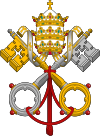
Marian prayers Alma Redemptoris Mater · Angelus · Ave Maria · Ave Maris Stella · Ave Regina Caelorum · Fatima Prayer · Magnificat · Memorare · Regina Coeli · Rosary · Salve Regina · Sub Tuum Praesidium · Three Hail Marys
Other prayers Act of Contrition · Adoro te devote · Angele Dei · Anima Christi · Athanasian Creed · Ave Verum Corpus · Benedictus · De Profundis · Jesus Prayer · Laudes Divinae · Miserere mei · Morning offering · Nunc Dimittis · O Salutaris Hostia · Prayer before a Crucifix · Prayer of Saint Francis · Prayer to Saint Michael · Requiem Aeternam · Spiritual Communion · Tantum Ergo · Te Deum · Thanksgiving after Communion · Veni Creator Spiritus · Veni Sancte Spiritus · Visit to the Blessed Sacrament · Way of the Cross
Categories:- Marian devotions
- Roman Catholic prayers
- Rosary
- Christian terms
Wikimedia Foundation. 2010.



